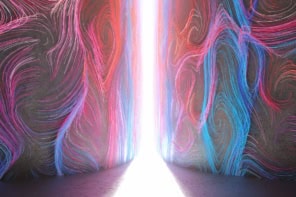
Pairs of entangled photons are a key ingredient of photonic quantum computers, quantum key distribution systems, and many quantum networking designs. Producing entangled photons on demand generally requires bulky lasers and prolonged alignment procedures – and this limits the commercial viability of these technologies. Now, a team of researchers in Germany and the Netherlands have used a new architecture to combine several integrated photonic technologies into one device. The result is a complete entangled photon source on a chip that is about the size of a one euro coin.
“This chip is very easy to use,” says team member Raktim Haldar, who is a postdoctoral researcher at Leibniz University Hannover. “You just plug it in and switch it on, and it can generate the quantum photons – you don’t need anything else or any other expertise.” He adds that in the future, the source could be found in every optical quantum processor in the same way that lithium-ion batteries are found in every electronic system today.
Photonic quantum bits (qubits) are one of several technologies that are competing to become the basis of future quantum computers. They offer several advantages over other types of qubits including those based on superconducting devices and trapped atoms or ions. For example, photonic qubits do not need to be cooled to cryogenic temperatures, and they are less susceptible to environmental noise that can destroy delicate quantum systems.
Difficult to entangle
On the downside, photonic qubits are more susceptible to losses and they are much more difficult to entangle – the latter being necessary for computations that involve more than one qubit at a time.
Integrated photonics, in which photons are confined to travel in micron-width waveguides printed on chips, offers a way to improve light-based quantum computers
“Photonic quantum computers have a big problem with loss,” says Elizabeth Goldschmidt, a quantum optics professor at the University of Illinois Urbana Champaign who was not involved in creating the new source. “Because interfaces are particularly lossy, going on-chip is very important.”
In their latest research, Haldar and colleagues have created a photonics system-on-a-chip that generates entangled photons. It consists of three main components: a laser; a filter ensuring laser stability at a narrow frequency band; and a non-linear medium generating entangled photon pairs. While lasers and quantum light sources requiring an external laser have been created on-chip before, putting both on the same chip has been a challenge. This is because the materials used for lasing are different from those required for filtering and entangled pair generation, and the manufacturing processes for the two materials are generally incompatible.
Hybrid integration
The team overcame this incompatibility using a technique called hybrid integration. The gain medium used for lasing was made from indium phosphide, while the filtering and photon-generation components were made from silicon nitride. To stick the two together, the team used the expertise of Klaus Boller’s group at the University of Twente. Boller’s team is adept at gluing different chips together with enough finesse that the microscopic light-guiding components line up and connect so perfectly that barely any light is lost at the interface. To avoid reflection at the interface, they added an anti-reflecting coating and tiled the end of the indium phosphide waveguide upwards off the chip by 9°. This allowed them to achieve less than 0.01 dB of loss across the interface.

Revived photon entanglement could enhance quantum communication and imaging
To aid in the seamless integration of all the components, the team chose a design in which the laser gain medium, filter, and photon-pair generation waveguides are all contained inside the lasing cavity. “They came up with this clever scheme to integrate both the filtering and the pair production into the same silicon nitride rings, and the laser on the same chip, which is very cool,” Goldschmidt explain.
Engineering the entire mechanism inside the laser cavity was no easy matter. In particular, the filter they employed had not been adapted for quantum light purposes, and they worked hard to adapt it. “The loss has to be equal to the total gain to maintain laser action,” says Haldar, “and that is a very difficult technical challenge. If a gap between two waveguides is, say, 200 nm, changing it to just 180 nm may make the whole chip not work.”
The chip creates pairs of frequency-entangled photons with 99% fidelity about 1000 times per second. The team is now working towards extending the on-chip photonic capabilities to include the creation of multiphoton cluster states. These are states comprising multiple entangled photons that could be used as effective qubits that are less susceptible to losses. Creating effective cluster states is a difficult open problem in quantum computing. Goldschmidt says, “multiplexing several of these sources on the same chip is a very clear path forward and lets you entangle more degrees of freedom and build up more complicated entangled states”.
They described their results in Nature Photonics.



